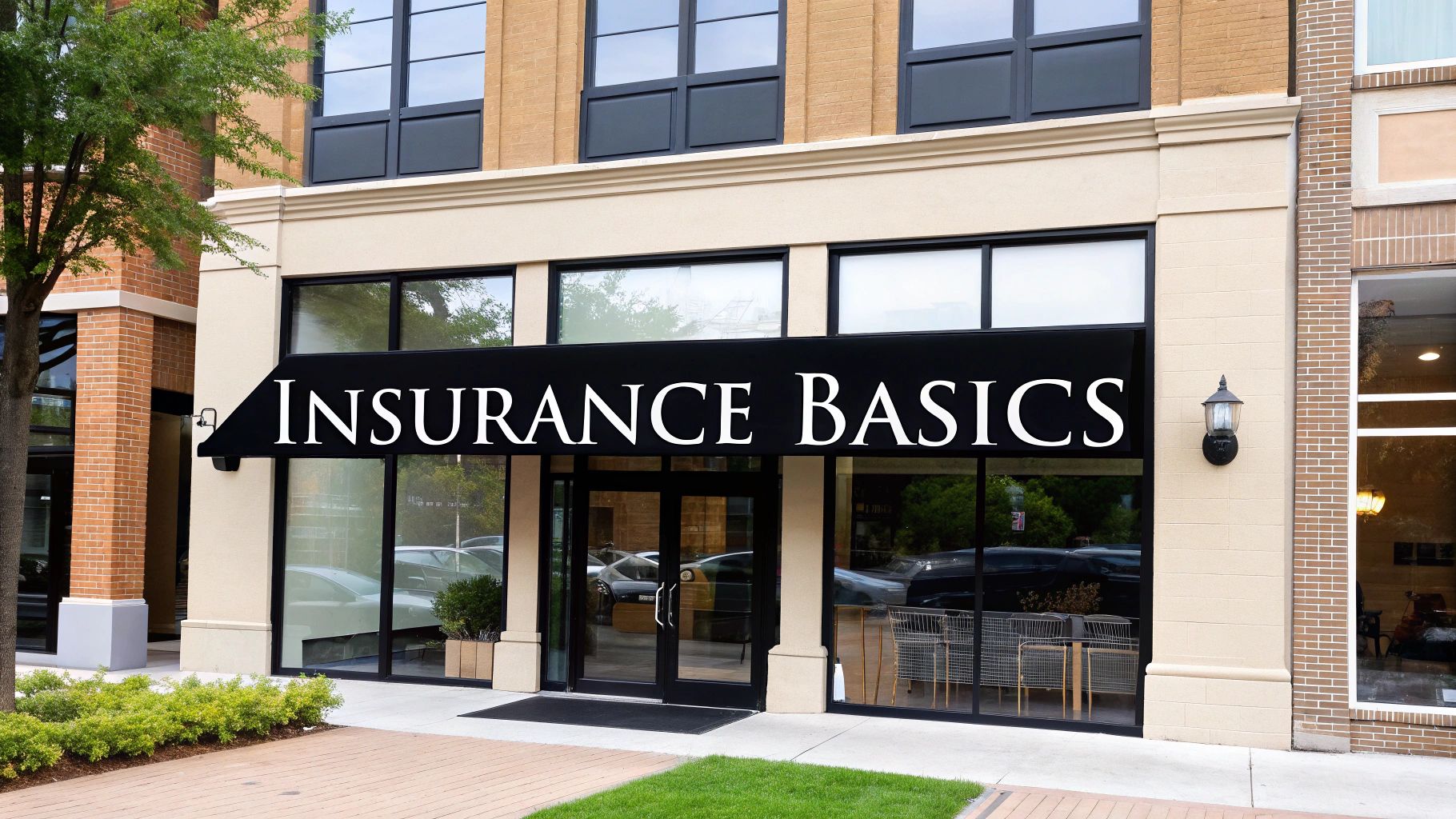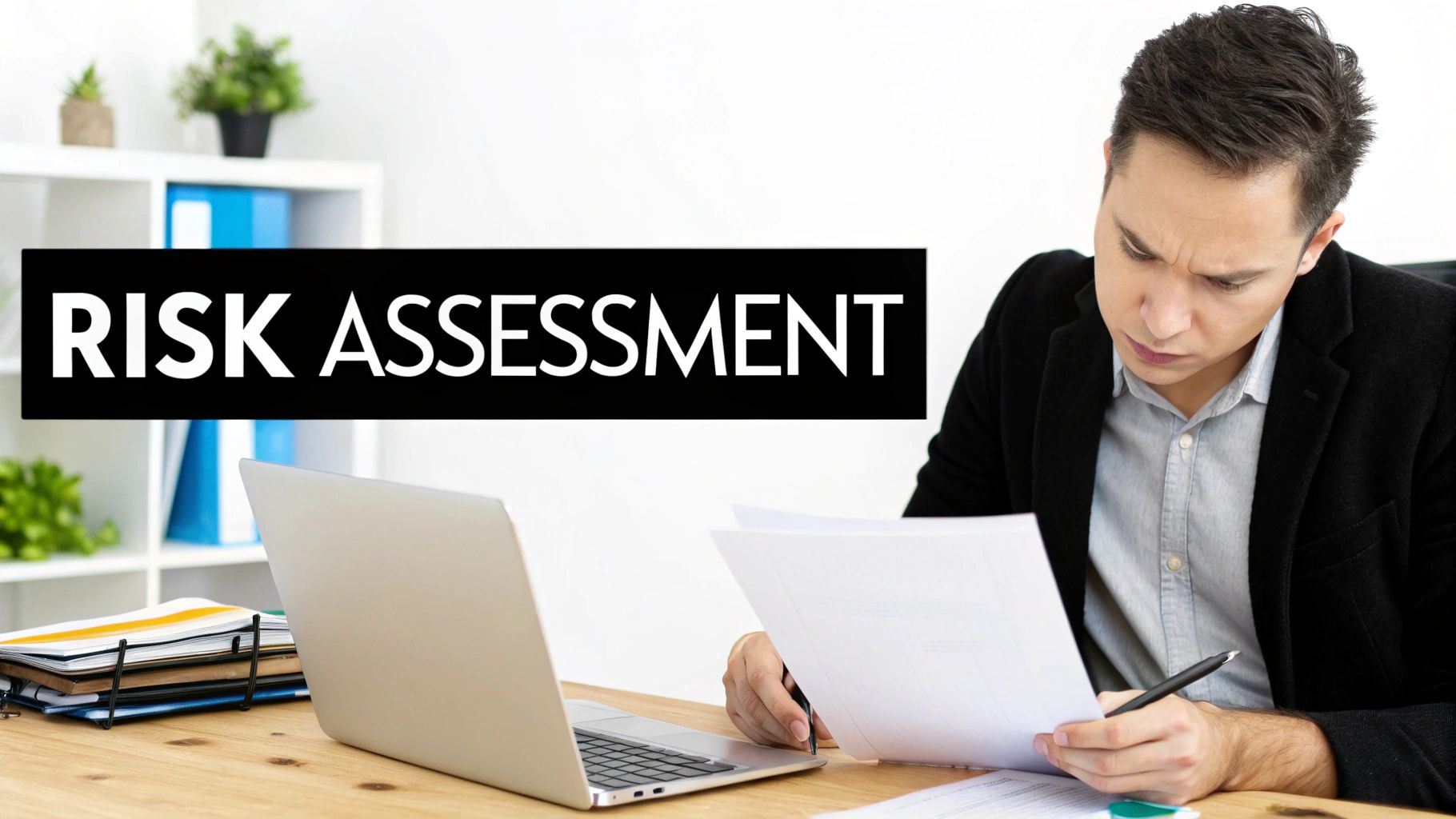Decoding Essential Small Business Insurance Requirements

Navigating small business insurance can be daunting. Understanding the essential requirements, however, is crucial for protecting your investment. This isn't just a formality; it's about securing your future. Let's explore the foundational coverage every small business needs.
Foundational Coverage: Protecting Your Core Operations
Several core insurance types are essential for most small businesses. These policies address common risks that could otherwise lead to significant financial setbacks.
-
General Liability Insurance: This covers common incidents such as customer injuries on your premises or property damage caused by your business operations. It’s a crucial safety net for everyday risks.
-
Commercial Property Insurance: This protects your physical assets, including your building, equipment, and inventory, from damage or loss due to events like fire, theft, or natural disasters. This is important whether you own or lease your workspace.
-
Workers' Compensation Insurance: If you have employees, this coverage is typically mandatory. It protects both your employees and your business in case of work-related injuries or illnesses.
-
Professional Liability Insurance (Errors and Omissions Insurance): For service-based businesses, this policy protects you from claims of negligence, mistakes, or inadequate work. It's especially vital for consultants, designers, and similar professions.
Business Structure and Insurance Needs: A Crucial Connection
Your business structure (sole proprietorship, partnership, LLC, or corporation) significantly impacts your insurance requirements. Sole proprietors, for instance, might be personally liable for business debts, making comprehensive liability coverage even more critical. LLCs and corporations offer some separation of personal and business liabilities, but specific insurance is still necessary.
Choosing the right insurance is not a one-size-fits-all process. It requires careful consideration of your business's legal structure and industry-specific risks. Surprisingly, many small business owners are underinsured. 40% of small business owners have no insurance, and 75% are inadequately insured, leaving them financially vulnerable. A general liability policy costs, on average, $42 per month, yet only 54% of small businesses have this essential coverage. Find more detailed statistics here: https://www.businessdasher.com/small-business-insurance-statistics/
Legally Required vs. Strategically Essential Coverage
Some insurance, like workers' compensation, is legally required. However, many crucial types, while not legally mandated, are strategically essential. Business interruption insurance, for example, can be a lifeline if a disaster forces you to close temporarily. This coverage helps replace lost income and cover ongoing expenses during recovery. Check out our guide on essential insurance policies: Top 5 Business Insurance Policies Every Small Business Needs in 2025. You might also be interested in: Top 5 Business Insurance Policies Every Small Business Needs.
Understanding the difference between legally required and strategically beneficial insurance is key to a comprehensive risk management strategy. This proactive approach protects your business, ensuring its resilience and longevity.
Navigating the Legal Maze: State-Specific Requirements
Understanding small business insurance requirements can feel overwhelming, especially when navigating the varying regulations across different states. This is particularly true for businesses operating in multiple locations. This section clarifies these complexities, helping you understand how to maintain compliance and avoid penalties.
Workers' Compensation: A Consistent Requirement With State-Specific Variations
Almost every state requires workers' compensation insurance. This coverage protects employees in case of work-related injuries or illnesses. However, the specifics of workers' compensation, like employee thresholds and industry exceptions, differ significantly by state. For example, some states require coverage even for single-employee businesses, while others have higher thresholds. Certain industries, such as agriculture, may also have unique rules.
To illustrate these variations, let's look at a comparison of workers' compensation requirements across a few states:
To help illustrate these state-specific nuances, the following table provides a comparison of workers' compensation insurance requirements.
State-by-State Workers' Compensation Requirements
This table compares workers' compensation insurance requirements across several states, highlighting employee thresholds and industry exceptions.
| State | Employee Threshold | Special Industry Requirements | Penalties for Non-Compliance |
|---|---|---|---|
| Texas | Generally, 1 or more | Exceptions exist for certain industries like domestic workers and agricultural operations. | Fines, potential jail time, and lawsuits from injured employees. |
| California | 1 or more | Specific rules for certain industries, including agriculture and household employees. | Substantial fines and potential stop-work orders. |
| New York | 1 or more | Variations for domestic workers, farm laborers, and other specific groups. | Fines, criminal charges, and potential civil lawsuits. |
| Florida | Generally, 4 or more for non-construction businesses, 1 or more for construction businesses | Exemptions for certain corporate officers and LLC members. | Fines, stop-work orders, and potential imprisonment. |
As shown in the table, the employee threshold and special industry requirements can vary significantly from state to state. Understanding these nuances is crucial for compliance.
Beyond Workers' Compensation: Understanding Other State Mandates
Beyond workers' compensation, states may require other types of insurance. These can include commercial auto insurance for business vehicles, professional liability insurance (also known as Errors and Omissions insurance) for certain professions, and liquor liability insurance for businesses that sell or serve alcohol. Each state sets its own requirements regarding coverage amounts and eligibility. Businesses operating across multiple states must carefully research each jurisdiction's specific mandates.
Small businesses are a significant part of the economy and the insurance market. In 2019, there were approximately 27.1 million active businesses in the United States, with 8 million classified as small businesses. Total insurance spending in the US reached $7.57 trillion in 2020, roughly 9.45% of the country's GDP, and the US held 56.2% of the OECD insurance market share. For more detailed information on commercial insurance statistics, you can visit: Business Initiative
Understanding Compliance Issues and Penalties
Failing to comply with state insurance requirements can lead to significant consequences. Penalties range from substantial fines to license suspensions, hindering a business's ability to operate. Non-compliance can also expose business owners to personal liability, putting personal assets at risk in the event of a lawsuit. One common mistake is assuming insurance from one state provides coverage in another. This is rarely the case, as policies are typically tailored to the laws of a specific state.
Strategies for Maintaining Compliance Across Multiple States
Multi-state businesses can navigate these complex requirements through careful research. Contacting the appropriate regulatory agencies in each state of operation is an essential first step. These agencies can provide detailed information on the specific insurance requirements for your industry and business structure. Working with an experienced insurance broker familiar with multi-state regulations is also a helpful strategy. A broker can help identify the necessary coverage to ensure compliance in each jurisdiction.
Resources for Staying Up-to-Date on Compliance
Staying informed on changes in insurance regulations is critical. State insurance departments often publish updates and resources on their websites. Subscribing to industry newsletters and attending webinars can offer valuable insights. Some states offer online databases to verify business insurance coverage, which is helpful for confirming compliance. By understanding these nuances and researching state-specific requirements, you can avoid penalties and ensure your business has adequate coverage.
Industry-Specific Protection: Beyond Basic Coverage

While foundational insurance policies are crucial, different industries face unique vulnerabilities. Standard coverage may not adequately address these specific risks. This section explores how small business insurance requirements vary across sectors, highlighting the importance of specialized protection.
Retail Businesses: Protecting Inventory and Customers
Retail businesses encounter risks related to customer injuries, inventory theft, and product liability. A simple incident like a customer slipping on a wet floor could result in a costly lawsuit, making general liability insurance essential. Protecting valuable inventory requires specific property insurance. Additionally, product liability insurance safeguards the business from claims arising from defective products.
Construction Companies: Covering On-Site Risks
The construction industry operates in a high-risk environment, demanding specialized coverage. Workers' compensation insurance is vital for protecting employees from work-related injuries, especially given the physically demanding nature of the job. Contractor's liability insurance covers potential damage to property or injuries to third parties during a project. Often, surety bonds are required to guarantee project completion and payment to subcontractors and suppliers.
Professional Services: Shielding Against Errors and Omissions
Professional services businesses, such as consultants, lawyers, and accountants, need professional liability insurance (also known as errors and omissions insurance). This policy protects against claims of negligence, mistakes, or inadequate work. For instance, a consultant's faulty advice leading to financial losses for a client could result in a substantial claim. This specialized coverage is crucial for maintaining professional reputation and financial stability.
Technology Companies: Addressing Cyber Threats and Data Breaches
Technology companies face increasing risks related to cyberattacks and data breaches. Cyber liability insurance is essential for protecting against these digital threats. This coverage can assist with data recovery costs, legal fees, and notification requirements following a breach. Furthermore, technology errors and omissions insurance protects against claims related to software malfunctions or service interruptions. You might be interested in: Understanding Business Insurance: A Complete Guide to What's Covered.
Contractual and Regulatory Requirements: Navigating Industry Standards
Beyond industry-specific risks, businesses often face contractual insurance requirements when bidding on projects or forming partnerships. These requirements frequently stipulate specific coverage types and amounts. Highly regulated industries, such as healthcare and finance, face stringent regulatory frameworks dictating minimum insurance coverage levels. Understanding these requirements is essential for securing contracts and maintaining compliance.
Real-World Examples and Case Studies: The Impact of Specialized Coverage
Real-world examples highlight the consequences of inadequate specialized coverage. A restaurant owner lacking sufficient liquor liability insurance faced bankruptcy after a patron caused an accident. A construction company with insufficient contractor's liability coverage incurred significant costs after damaging client property. These cases underscore the importance of securing appropriate coverage for specific business vulnerabilities.
Value vs. Expense: Choosing the Right Specialized Coverage
Choosing the right specialized coverage involves careful consideration. Some policies offer significant value by protecting against major risks, while others might be less relevant. Businesses should assess their vulnerabilities and prioritize coverage addressing the most likely and costly scenarios. By focusing on industry-specific risks and understanding contractual and regulatory requirements, businesses can build a robust insurance strategy to protect against significant threats.
Emerging Risks Reshaping Small Business Insurance Needs
The business world is in constant flux, bringing with it a wave of new risks. What was sufficient protection for a small business yesterday may be inadequate today. Understanding and addressing emerging risks is critical for small business owners, and this includes adapting small business insurance requirements to meet these evolving challenges.
The Digital Transformation and Cyber Threats
One of the most significant shifts in the modern business world is the increased dependence on technology. This digital transformation, while presenting incredible opportunities, also creates new vulnerabilities, particularly regarding cyberattacks. Data breaches, ransomware attacks, and other cyber threats can devastate a small business, resulting in financial losses, reputational damage, and legal repercussions.
This makes cyber liability insurance no longer a luxury, but a necessity for many small businesses. This coverage helps businesses recover financially from a cyberattack, covering costs such as data recovery, legal fees, and notification expenses.
Climate Volatility and Business Interruption
The increasing frequency and intensity of extreme weather events due to climate change represent another significant risk for small businesses. Hurricanes, floods, wildfires, and other natural disasters can disrupt operations, damage property, and lead to substantial financial losses. Traditional business interruption insurance often proves insufficient in addressing the unique challenges posed by these modern disruptions.
Proactive businesses are exploring updated business interruption policies that provide more comprehensive coverage for climate-related events. These policies take into account the extended downtime that can occur from supply chain disruptions and damage to infrastructure, helping businesses weather the storm and recover more effectively.
Evolving Work Models and Liability Concerns
The rise of remote work and the gig economy has reshaped traditional employment models. These shifts introduce new considerations for small business insurance requirements. For instance, businesses with remote employees may need to adjust their workers' compensation and general liability coverage to account for off-site work environments. Furthermore, businesses that rely on independent contractors may encounter unique liability issues.
Understanding these evolving work models and their associated risks is crucial for effectively tailoring insurance coverage. This enables businesses to provide adequate protection for both their employees and operations in this new landscape. A Deloitte survey highlights this growing concern: in 2021, a study of 5,300 small business insurance buyers, including 501 US respondents (82% of whom generated less than $7 million annually), revealed increasing anxiety about being underinsured against emerging risks. Find more detailed statistics here.
Adapting to Emerging Risks: A Proactive Approach
Staying ahead of emerging risks demands a proactive approach to insurance. This involves regularly reviewing your current coverage, identifying potential vulnerabilities, and exploring new insurance products designed to address modern threats. You might be interested in: The Future of Small Business Insurance: Best Picks for 2025
By collaborating with insurance professionals and staying informed about evolving business risks, small business owners can adapt their protection strategies. This helps minimize potential losses and ensures long-term sustainability. This proactive approach to small business insurance requirements is not simply about protecting against potential threats; it's about ensuring the future viability of your business in a constantly changing world.
Smart Spending: Maximizing Protection While Controlling Costs

Securing the right insurance for your small business is essential, but the costs can add up quickly. Many business owners are looking for ways to maximize their protection while keeping expenses under control. This section explores practical strategies to get the most value from your small business insurance requirements.
Bundling Policies: One-Stop Savings
One effective cost-saving measure is policy bundling. This involves purchasing multiple insurance policies, such as general liability and commercial property insurance, from a single provider. Many insurers offer discounts for bundled policies, resulting in potentially significant savings compared to buying each policy separately. It's similar to buying in bulk—greater value for a lower overall cost.
Adjusting Deductibles: Balancing Risk and Savings
Another key strategy involves adjusting your deductible. Your deductible is the amount you pay out-of-pocket before your insurance coverage begins. A higher deductible often translates to a lower premium. However, it's essential to select a deductible you can comfortably afford in the event of a claim. Carefully consider your business's financial stability and risk tolerance when making this decision.
Implementing Risk Management Programs: Proactive Protection
A proactive approach to risk management can substantially reduce insurance costs. Implementing strong safety protocols, employee training programs, and regular equipment maintenance can minimize accidents and claims. For example, a restaurant with a thorough food safety program is less likely to encounter food poisoning claims, which could lead to lower liability insurance premiums.
Working With Independent Agents: Accessing More Options
Selecting the right insurance provider can also influence your bottom line. Independent insurance agents frequently represent multiple insurance carriers, providing you with access to a wider range of policy options and pricing. This lets you compare quotes and select the best value for your business. Working directly with a single insurance company, on the other hand, restricts your options.
Understanding Premium Calculations: Knowing the Key Factors
Understanding how insurance premiums are calculated is crucial for making informed decisions about your coverage. Factors like business location, industry, revenue, claims history, and the number of employees all play a role in determining your premium. For instance, a business in a high-crime area might have higher property insurance premiums.
To illustrate the potential cost variations across different business types and coverage needs, consider the table below:
Insurance Cost Comparison by Business Type
This table shows average annual premium costs for essential coverage types across different small business categories. These figures are for illustrative purposes and can vary significantly based on specific circumstances. Consult with an insurance professional for personalized quotes.
| Business Type | General Liability | Professional Liability | Workers' Comp | Business Property | Total Annual Cost |
|---|---|---|---|---|---|
| Restaurant | $1,200 | N/A | $2,500 | $1,800 | $5,500 |
| Retail Store | $1,000 | N/A | $1,500 | $1,500 | $4,000 |
| Consultant | $800 | $1,500 | N/A | $500 | $2,800 |
| Office-Based Business | $700 | $1,200 | $500 | $800 | $3,200 |
As the table shows, the total annual insurance costs can differ significantly depending on the nature of the business. Businesses with higher risk profiles or those requiring specialized coverage, such as professional liability, will typically face higher premiums.
Cost-Cutting vs. Coverage Gaps: Finding the Right Balance
Saving money is important, but be careful about cutting corners that might create coverage gaps. Reducing liability coverage limits to save a small amount might seem appealing, but it could leave your business vulnerable to substantial financial risk in the event of a significant claim. It's vital to strike a balance between cost savings and adequate protection. Real-world examples demonstrate the importance of this balance. One small business owner reduced their premium by implementing robust cybersecurity measures, mitigating the risk of cyberattacks and justifying lower cyber liability coverage. Conversely, another business faced devastating losses from a fire they weren’t fully covered for after underinsuring their property. These contrasting scenarios underscore the importance of strategic cost management without compromising essential protection. By carefully evaluating your small business insurance requirements, understanding the factors affecting premiums, and implementing smart cost-saving strategies, you can secure comprehensive protection without overspending. This empowers you to focus on business growth, secure in the knowledge that you’re adequately protected.
Tailoring Coverage to Your Unique Business Vulnerabilities
Cookie-cutter insurance policies rarely offer the precise protection your business needs. Just as a tailor creates custom clothing, your insurance should be tailored to your specific vulnerabilities. This section explores how to assess your unique risks and build an insurance strategy that genuinely safeguards your business.
Identifying Your Business's Vulnerability Points
The first step in tailoring your coverage is understanding your business's unique risks. This involves a comprehensive assessment of potential vulnerabilities across various aspects of your operations.
-
Physical Assets: What are your most valuable physical assets (buildings, equipment, inventory)? What risks do they face (fire, theft, natural disasters)?
-
Operational Risks: What processes are essential to your operations? How could disruptions (supply chain issues, technology failures) impact your business?
-
Employee Dynamics: Do you have employees? What risks arise from their work (workers' compensation claims, employment practices liability)?
-
Customer Interactions: How do you interact with customers? What risks are associated with these interactions (slip-and-fall accidents, product liability)?
For example, a restaurant faces different risks than a software company. The restaurant needs to consider food spoilage, liquor liability, and on-site accidents. The software company, on the other hand, should prioritize cyber liability and intellectual property protection.
Prioritizing Protection Based on Potential Impact
Once you’ve identified your vulnerabilities, prioritize them based on the potential financial impact. A catastrophic event like a major fire could be more devastating than a minor slip-and-fall accident. This prioritization helps determine where to focus your insurance resources. Imagine a scale – the higher the potential impact, the higher the priority for coverage.
Developing an Insurance Strategy: From Assessment to Action
After prioritizing your risks, you can develop a targeted insurance strategy. This involves selecting policies that directly address your most significant vulnerabilities. This may include a combination of standard policies, like general liability insurance, and specialized policies tailored to your industry and specific risks.
For example, a construction company might require surety bonds and contractor’s liability insurance in addition to general liability and property insurance. This is because they face unique risks related to project completion and potential damage to third-party property. This strategic approach to small business insurance requirements is about aligning your coverage with your specific needs.
Conducting Your Assessment: Tools and Frameworks
Several tools and frameworks can assist in conducting your risk assessment. Simple worksheets can help you list your assets, potential threats, and the likelihood of those threats occurring. More sophisticated risk management software can provide a more in-depth analysis of your vulnerabilities. This assessment is a crucial step in determining your small business insurance requirements.
Seeking Expert Advice: When to Bring in the Professionals
While some businesses can handle insurance decisions internally, others benefit from expert advice. An independent insurance broker can assess your risks, recommend appropriate coverage, and help you compare quotes from different providers. They can also offer guidance on complex insurance matters and ensure your policies align with your specific circumstances. Think of them as your insurance navigators, helping you chart the best course for your business. This helps ensure you have adequate protection without unnecessary expense, optimizing your small business insurance requirements.
Dangerous Coverage Gaps: What Your Policies Might Be Missing

Even with multiple insurance policies, many small businesses have critical gaps in their coverage. These gaps can lead to financially devastating consequences, meaning even seemingly comprehensive insurance plans may leave your business exposed. This section will uncover common coverage blind spots and offer practical solutions for strengthening your protection.
Misunderstood Exclusions and Limitations: Reading the Fine Print
One of the most common sources of coverage gaps comes from misunderstood policy exclusions and limitations. Many business owners assume their policies cover more than they do. For example, a standard general liability policy might exclude coverage for certain types of professional services or incidents that occur off your business premises.
Additionally, coverage limitations, often hidden in the fine print, may restrict the payout amount for specific claims, leaving you responsible for the difference. Carefully reviewing your policies and seeking clarification from your insurance provider is crucial.
Inadequate Liability Limits: When Coverage Falls Short
Another dangerous gap arises from inadequate liability limits. Opting for the lowest possible liability coverage to save on premiums can backfire if a significant claim arises.
If your business faces a lawsuit with damages exceeding your coverage limits, you will be personally liable for the excess amount. This can jeopardize your personal assets and the future of your business. Adequate liability limits are crucial for protection against catastrophic losses.
Missing Cyber Coverage: A Growing Threat
Cyberattacks are a significant and growing threat to small businesses. Despite this, many businesses lack adequate cyber insurance. This lack of protection is concerning, especially considering the financial impact of a cyberattack.
Statistics highlight the growing risk: only 31% of small and medium businesses have cyber insurance, yet 57% have experienced cybersecurity breaches. Average cyber claims reach $345,000. Further explore this topic. Without cyber insurance, businesses face substantial costs related to data recovery, legal fees, and regulatory fines after a data breach. Additionally, health insurance remains a challenge; only 56% of small employers provide it, with 65% citing expense as the main obstacle.
Business Interruption Vulnerabilities: Protecting Your Income
Many businesses overlook business interruption insurance. This coverage replaces lost income and covers ongoing expenses if your business is forced to close temporarily due to unforeseen events like natural disasters or fires.
Without this protection, even a short disruption can severely impact your business's financial stability. Protecting your income stream with business interruption insurance is a key element of a comprehensive risk management strategy.
Closing the Gaps: Strategic Policy Enhancements
Addressing coverage gaps is achievable through strategic policy enhancements. This involves carefully reviewing your existing policies, identifying potential vulnerabilities, and working with an insurance professional to add necessary coverage.
This might involve increasing liability limits, adding cyber insurance, or securing business interruption coverage. Prioritizing these enhancements is an investment in the long-term security and success of your small business. Understanding your small business insurance requirements and addressing potential gaps isn't just a best practice—it’s essential for protecting your hard work.
Comments are closed.